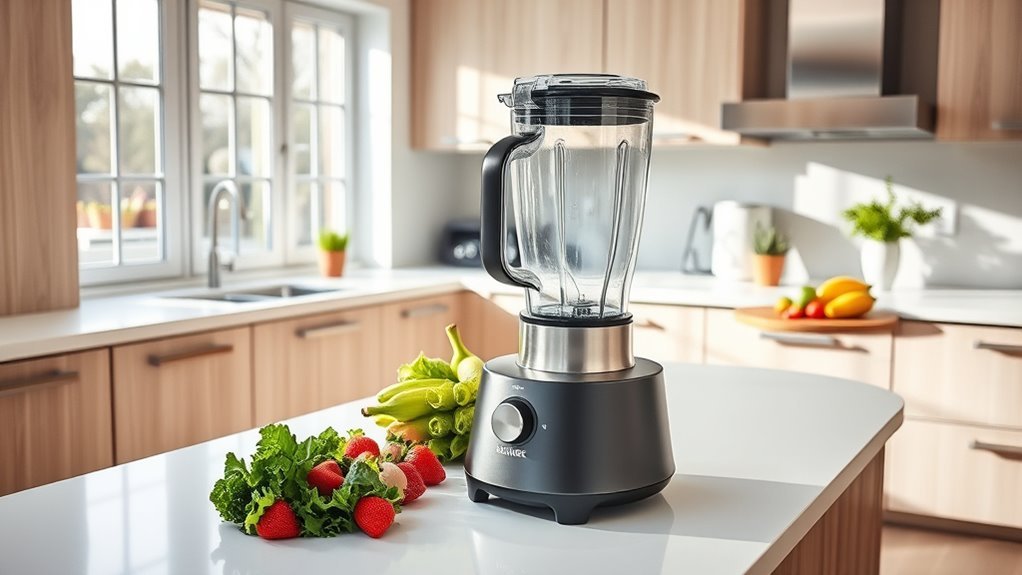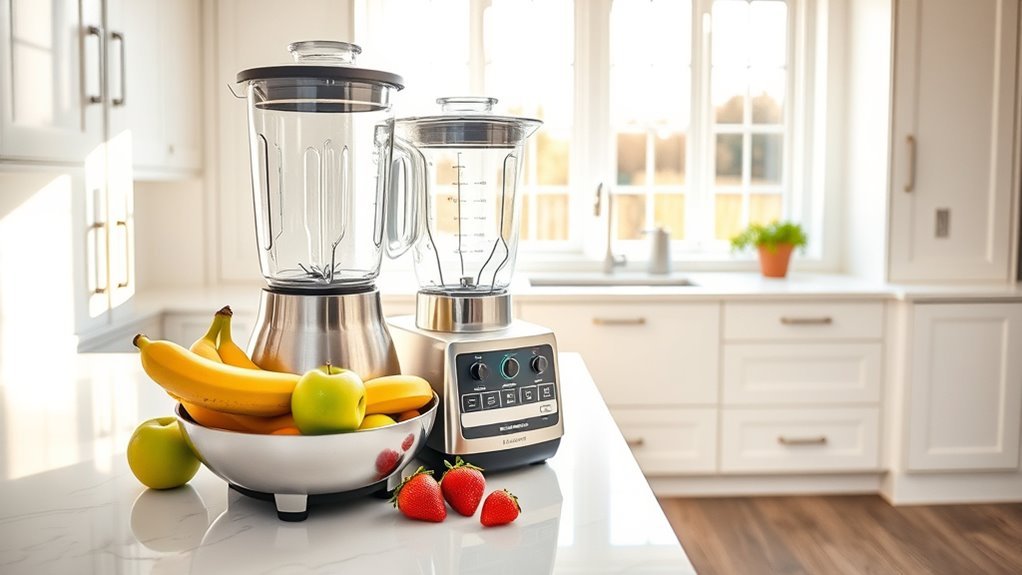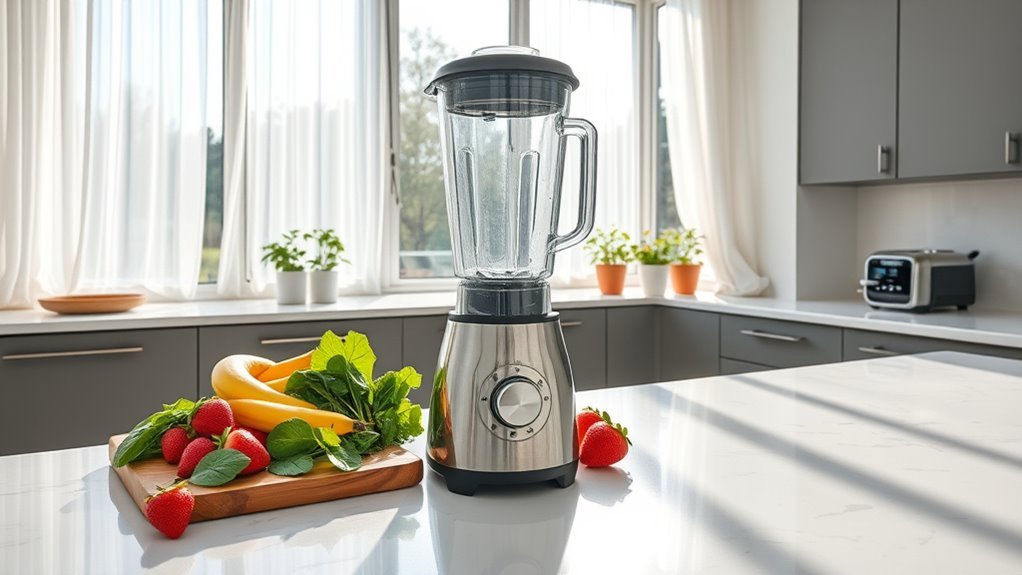We’ll tame your roaring blender with proven noise-reduction techniques that actually work. Start by placing a thick dish towel or silicone mat under the base to absorb vibrations. Position your blender away from hard surfaces like granite countertops and concrete walls that amplify sound. Regular maintenance keeps blades sharp and parts tight, reducing overall noise. Want maximum silence? A custom sound barrier box can slash noise levels by 40%.
Understanding Why Blenders Make Noise

While blenders are essential kitchen tools, their ear-splitting noise levels stem from multiple mechanical factors working in concert.
We’re dealing with powerful motor speeds up to 35,000 rpm, creating intense operational sounds that echo through our kitchens. Those stainless steel blades aren’t just chopping – they’re generating friction and impact noise as they tackle ingredients at breakneck speeds.
Want to reduce blender noise? First, understand that vibrations transfer through countertops, especially with materials like granite that love to amplify sound.
No sound enclosure can fully tackle the root causes: rattling parts, aging motors, and dull blades that struggle with tough ingredients. It’s worth noting that high-performance blenders can handle tough ingredients more efficiently, which may help reduce noise levels during operation.
Here’s the kicker – even high-end motors above 1,000 watts can’t eliminate noise entirely, but they’ll handle ingredients more efficiently, reducing unnecessary racket.
Simple Solutions for Immediate Noise Reduction
Before investing in expensive sound-dampening equipment, you’ll want to try these dirt-simple fixes that can slash your blender’s noise instantly.
Let’s start with the dish towel trick – simply place a thick one under your blender to absorb those jarring vibrations and drop noise levels considerably.
We’ve got more quick fixes in our arsenal. Sound dampening pads under the blender’s feet will isolate vibrations from your countertop.
Or grab a trivet or silicone mat – they work wonders as sound barriers. Just remember: don’t block those vents. Your blender needs proper airflow to function safely.
Interestingly, high-performance blenders typically offer enhanced versatility in the kitchen, which can often lead to increased noise levels during operation.
These solutions won’t turn your blender into a whisper-quiet machine, but they’ll make that morning smoothie ritual a lot more bearable – and your family will thank you.
Creating an Effective Sound Barrier System

Quick fixes are great, but let’s take your blender noise reduction to the next level with a proper sound barrier system. Those powerful motors won’t stand a chance against our scientifically-designed sound enclosures.
Start by constructing a box using medium-density fiberboard or plywood – these materials are perfect for containing the racket. Line the interior with high-density insulation foam or mass-loaded vinyl to boost soundproofing capabilities.
Don’t skip the acoustic foam panels – they’re vital for absorbing those pesky sound waves bouncing around inside.
We’ll add a hinged door for easy access. When done right, you’re looking at a 40% noise reduction. That’s the difference between a screaming banshee and a manageable kitchen companion. Trust us, your ears will thank you.
Positioning and Surface Considerations
Since your blender’s location can make or break its noise level, let’s optimize its positioning for maximum sound reduction.
We’ll start by moving it away from concrete or hard walls that amplify those ear-splitting echoes.
Here’s your action plan: Place a thick sound-dampening mat under your blender – it’s your first line of defense against vibrations.
We’re talking isolation 101 here. Position the unit on a rock-solid, flat surface, and whatever you do, keep it off granite or stainless steel countertops – they’re noise amplification machines.
Don’t forget those rubber or silicone pads under the feet; they’re critical for vibration control. Think of them as tiny shock absorbers for your blender.
Trust us, these positioning tweaks make a dramatic difference.
Long-term Maintenance for Quieter Operation

The right positioning sets the stage, but your blender’s long-term noise level depends on proper maintenance.
Let’s tackle the essentials of keeping your noisy blender in check.
Start with regular cleaning – it’s not just about hygiene. Food buildup forces your motor and blades to work harder, cranking up the sound.
Keep those blades sharp; dull ones scream for attention. While an enclosure box helps muffle noise, long-term maintenance is your secret weapon.
Check those rubber cushion pads regularly – they’re your front-line defense against vibration.
Spot any loose parts? Tighten them before they turn into a rattling symphony.
Your blender’s home matters too – a stable surface means less vibration and quieter operation.
Trust us, these maintenance steps make your blender purr instead of roar.
Frequently Asked Questions
How to Make a Blender Sound Quieter?
Let’s make muffled magic! We’ll reduce blender noise using sound-absorbing mats, acoustic foam padding, and proper maintenance. Place dampening pads under feet and consider building a soundproof enclosure for quieter operation.
How Do I Reduce Noise in Blender?
Let’s reduce blender noise by using vibration dampening pads underneath, installing an acoustic foam enclosure, and placing a thick mat below. Consider quiet blender models or soundproofing techniques for better results.
What Is the Most Quiet Blender?
Based on silent blender reviews, we’ve found the CRANDDI soundproof model ranks among the best quiet blenders, featuring superior soundproofing techniques and a powerful 2,200-watt motor for low-noise operation.
Why Are Blenders so Noisy?
We experience noisy blenders because high-speed motors and spinning blades create intense vibrations, while the impact of ingredients against metal surfaces amplifies sound. Without proper insulation, these mechanical forces produce significant kitchen noise.

